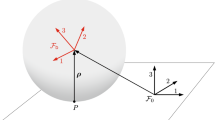Abstract
Using the Kotelnikov–Study transference principle, a generalization of the Hamilton–Ishlinskii solid angle theorem for spatial motion of a solid that is a composition of translational and rotational motions and the dual conjugate theorem for the body motion are presented. An example of the studied spatial motion of a solid is considered. Possible applications of the dual solid angle theorem in the theory of spatial mechanisms and the mechanics of robotic manipulators are pointed out. Its application for the inertial navigation problem for determining the orientation and apparent velocity of a moving object is given. In considering the example and application, biquaternionic kinematic equations and their analytical solutions are used for the solid’s spatial motions under consideration. In the present study, the results obtained earlier by the author of the article are developed and generalized.
Similar content being viewed by others
References
A. Yu. Ishlinskii, Mechanics of Special Gyroscopic Systems (Akad. Nauk UkrSSR, Kiev, 1952) [in Russian].
A. Yu. Ishlinskii, Orientation, Gyroscopes, and Inertial Navigation (Nauka, Moscow, 1976) [in Russian].
W. R. Hamilton, Lectures on Quaternions (Hodges and Smith, Dublin, 1853).
L. E. Goodman and A. R. Robinson, “Effect of Finite Rotations on Gyroscopic Sensing Devices,” J. Appl. Mech. 25 (2), 210–213 (1958).
V. Ph. Zhuravlev, Foundations of Theoretical Mechanics (Fizmatlit, Moscow, 2008) [in Russian].
Yu. K. Zhbanov and V. Ph. Zhuravlev, “On Certain Properties of the Finite Rotations of a Rigid Body in the Presenceof a Nonholonomic Constraints,” Izv. Akad. Nauk SSSR Mekh. Tv. Tela, No. 1 9–14 (1978).
V. Ph. Zhuravlev, “The Solid Angle Theorem in Rigid Body Dynamics,” Prikl. Mat. Mekh. 60 (2), 323–326 (1996) [J. App. Mat. Mech.(Engl. Transl.) 60 (2), 319–322 (1996)].
V. Ph. Zhuravlev, “The Geometry of Conical Rotations,” Izv. Ros. Akad. Nauk Mekh. Tv. Tela, No. 3, 11–21 (2004) [Mech. Sol. (Engl. Transl.) 39 (3), 5–13 (2004)].
Yu. N. Chelnokov, “Hamilton–Ishlinskii Solid Angle Theorem and its Generalization for Nonholonomic Spatial Motion of a Solid,” in Mathematics, Mechanics, Collection of Papers, No. 7 (Izd-vo Saratov Univ., Saratov, 2005), pp. 198–202 [in Russian].
Yu. N. Chelnokov, Quaternion and Biquaternion Models and Methods of Mechanics of Solids and Their Applications (Fizmatlit, Moscow, 2006) [in Russian].
A. P. Kotelnikov, Helical Calculus and Some of Its Applications to Geometry and Mechanics (Kazan, 1895) [in Russian].
A. P. Kotelnikov, “Screws and Complex Numbers,” Izv. Fiz.-Mat. Obshch. Imper. Kazan. Univ. Ser. 2, No. 6, 23–33 (1896).
A. P. Kotelnikov, “Theory of Vectors and Complex Numbers,” in Several Applications of Lobachevskii’s Ideas in Mechanics and Physics, Collection of Papers (Gostekhizdat, Moscow, 1950), pp. 7–47 [in Russian]
E. Study, Über neue Darstellung der Krafte. Berichte über der Verhandlung der Sachs (Akad. Gess. der Wiss., Math. Teil, Leipzig, 1899).
E. Study, Über Nicht-Euklidische und Liniengeometrie (Festschr. der Philoa. Fakult. zu Greifswald, 1900).
F. M. Dimentberg, Theory of Screws and Its Applications (Nauka, Moscow, 1978) [in Russian].
W. Clifford, “Preliminary Scetch of Biquaternions,” Proc. London Math. Soc. 4, 381–395 (1873).
Yu. N. Chelnokov, “On Integration of Kinematic Equations of a rigid Body’s Screw-Motion,” Prikl. Mat. Mekh. 44 (1), 32–39 (1980) [J. Appl. Math. Mech. (Engl. Transl.) 44 (1), 19–21 (1980)].
Yu. N. Chelnokov, “One Form of the Equations of Inertial Navigation,” Izv. Akad. Nauk SSSR Mekh. Tv. Tela, No. 5, 20–28 (1981) [Mech. Sol. (Engl. Transl.) 16 (5), 16–23 (1981)].
Yu. N. Chelnokov, “On Stability of Solutions to Biquaternion Kinematic Equations of Helical Motion of Solids,” in Collection of Sci.-Method. Papers on Theor. Mech. (Vysshaya Shkola, Moscow, 1983), No. 13, pp. 103–109 [in Russian].
Yu. N. Chelnokov, “On Determining Vehicle Orientation in the Rodrigues–Hamilton Parameters from its Angular Velocity,” Izv. Akad. Nauk SSSR Mekh. Tv. Tela, No. 3, 11–20 (1977) [Mech. Sol. (Engl. Transl.) 37 (3), 8–16 (1977)].
V. N. Branets and I. P. Shmyglevskii, Application of Quaternions in Problems of Attitude Control of a Rigid Body (Nauka, Moscow, 1973) [in Russian].
Yu. N. Chelnokov, “Equations and Algorithms for Determining the Inertial Attitude and Apparent Velocity of a Moving Object in Quaternion and Biquaternion 4D Orthogonal Operators,” Izv. Ros. Akad. Nauk Mekh. Tv. Tela, No. 2, 17–25 (2016) [Mech. Sol. (Engl. Transl.) 51 (2), 148–155 (2016)].
Author information
Authors and Affiliations
Corresponding author
Additional information
Russian Text © The Autor(s), 2019, published in Izvestiya Akademii Nauk, Mekhanika Tverdogo Tela, 2019, No. 6, pp. 41–63.
About this article
Cite this article
Chelnokov, Y.N. Generalization of Hamilton–Ishlinskii Solid Angle Theorem for Spatial Motion of a Solid Body and its Applications. Mech. Solids 54, 1227–1239 (2019). https://doi.org/10.3103/S0025654419080132
Received:
Revised:
Accepted:
Published:
Issue Date:
DOI: https://doi.org/10.3103/S0025654419080132




